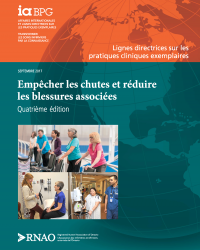Preventing Falls and Reducing Injury from Falls (4th ed.) replaces the RNAO (2011) BPG Prevention of Falls and Fall Injuries in the Older Adult, which was originally published in 2002 and then revised in 2005, 2011 and 2017.
Whereas previous editions focused on older adults in hospital and long-term-care settings, the scope of this third edition has been expanded to include in all adults (>18 years) at risk for falls and receiving care from nurses and other health-care providers across the health-care continuum, including those living in the community.
The purpose of this guideline is to outline evidence-based approaches for preventing falls and reducing fall injuries for adults.
Recommendations are provided at the following three levels:
- Practice recommendations are directed primarily toward nurses who provide direct clinical care to adults at risk for falls across the continuum of care, including (but not limited to): primary care, home care, hospital care, and long-term care settings. The secondary audience of the practice recommendations includes other members of the interprofessional team who collaborate with nurses to provide comprehensive care. All of the recommendations are applicable to the scope of practice of registered nurses and nurse practitioners (general and extended classes); however, many are also applicable to other health-care providers.
- Education recommendations are directed at individuals and organizations responsible for the education of healthcare providers, such as educators, quality improvement teams, managers, administrators, academic institutions, and professional organizations.
- Organization and policy recommendations are directed at those managers, administrators, and policy-makers responsible for developing policy or securing the supports required within health-care organizations that enable the implementation of best practices. For optimal effectiveness, recommendations in these three areas should be implemented together.

